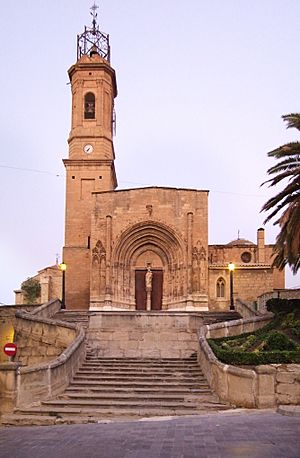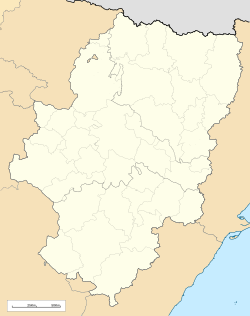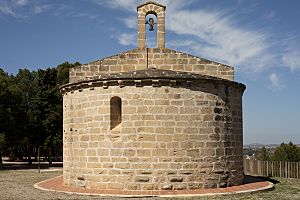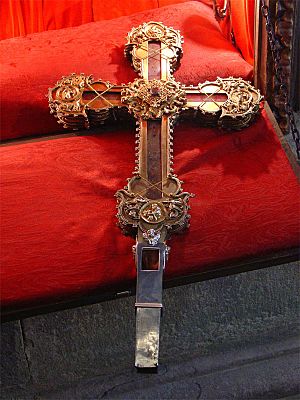Caspe facts for kids
Quick facts for kids
Caspe
|
|||
|---|---|---|---|

Collegiate Church of Santa Maria la Mayor
|
|||
|
|||
| Country | |||
| Autonomous community | |||
| Province | Zaragoza | ||
| Comarca | Bajo Aragón-Caspe/Baix Aragó-Casp | ||
| Area | |||
| • Total | 503.33 km2 (194.34 sq mi) | ||
| Elevation | 150 m (490 ft) | ||
| Population
(2018)
|
|||
| • Total | 9,525 | ||
| • Density | 18.9240/km2 (49.0128/sq mi) | ||
| Demonym(s) | Caspolinos | ||
| Postal code |
50700
|
||
Caspe is a town in Spain. It is located in the province of Zaragoza, which is part of the Aragon region. Caspe is also the main town of the Bajo Aragón-Caspe/Baix Aragó-Casp area.
In 2018, about 9,525 people lived there. The town covers an area of 503.33 square kilometers. This makes it the fourth largest town in Aragon. Caspe became a "city" in the 1800s. This was a special honor given by Queen Isabella II. It was because of the damage the town suffered during the Carlist Wars.
Contents
What's in a Name?
Some people think Caspe got its name from ancient people. They believe these people came from the Caspian Sea. But this idea is not supported by language experts.
The name Casp was written as "Qsp" or "Qasb" in old Arab texts. It might be linked to the Arabic word "Casba." Another idea is that the name comes from an old European word. Cass means "oak" and pe means "place of" or "below."
Where is Caspe?
Caspe is located in a dry part of Aragon. It is about 104 kilometers southeast of Zaragoza. The town sits near the Guadalope river. This river no longer flows through Caspe. Its water was moved when the Mequinenza Dam was built. The dam created a large lake called the Sea of Aragon. Caspe is also close to the Ebro river.
The town is 152 meters above sea level. The average temperature is 15 °C. It gets about 325 mm of rain each year. Caspe is an important meeting point. It connects the Ebro river area (east-west) with a path from Andorra to Barbastro and Monzón (north-south).
Animals and Plants
Caspe has many different animals and plants. This is because it has different types of land. These include dry plains, river areas, forests, and Mediterranean woodlands.
You can see many birds of prey here all year. These include golden eagles and Eurasian griffon vultures. In winter, you might spot European merlins. In summer, look for black kites and Egyptian vultures. At night, long-eared owls and little owls are active.
The dry plains are home to birds like the great bustard. You can also find black-bellied sandgrouse and pin-tailed sandgrouse. Plants like juniper, rosemary, and thyme grow here.
Near the rivers, there are special forests. These forests are home to mallard ducks and gray herons. They are mostly made of black poplars and reeds. Forest birds like sparrowhawks and turtle doves live here too. The Mediterranean forests have Aleppo pine trees.
Many mammals live in Caspe. These include red deer, wild boar, and foxes. You might also see otters, weasels, and rabbits. There are also many amphibians and reptiles. Common toads and frogs live in ponds. Lizards and different types of snakes are found throughout the area.
Caspe is also home to many white storks. In 2018, there were 17 stork pairs living in the town. They often nest on old buildings.
Ancient Times
Caspe has signs of very old human activity. A stone tool called a biface was found in the Cauvaca area. It is about 100,000 to 150,000 years old. This shows that Neanderthal hunter-gatherers passed through here.
One special place is the Plano del Polido site. It has ancient cave paintings. These paintings show deer and possibly an archer.
Around 800 BC, more people started living in Caspe. They built towns and burial mounds. These people were part of the Hallstatt culture from the early Iron Age.
Later, during the Iberian era, towns like Loma de los Brunos appeared. The town of La Tallada was also important. It was lived in from the 4th century BC until it was destroyed around 100 BC.
When the Romans arrived, they built villas. These were like large country houses. The Miralpeix Mausoleum is a Roman tomb from the 2nd or 3rd century AD. It was moved to its current spot because of the Mequinenza Dam construction.
History of Caspe
Early History
Before the Romans took over Spain, the Caspe area was home to the Sedetani people. They were an Iberian group.
Middle Ages
Muslims arrived in 713 AD. The Ebro river lands became the northern part of Al-Andalus. This was a Muslim-controlled area. Over time, most people became Muslim.
In 1169, Caspe became part of the Crown of Aragon. This happened when King Alfonso II conquered the town. Most of the people living in Caspe at that time were Muslim. They were allowed to keep their religion. But they had to move outside the city walls. Jews also lived in Caspe at this time.
Caspe was then given to the Order of Saint John of Jerusalem. This was a group of knights. Their castle in Caspe became an important center. By the late 1200s, Caspe had about 1,500 people. The town grew around the castle and the church of Santa María.
In 1392, Juan Fernández de Heredia, a leader of the Order, bought land in Caspe. He built a convent and made the church a special "collegiate church." He also brought important religious items, like a piece of the cross Christ died on (a lignum crucis).
Caspe was a major center for making glass in medieval times. It was one of the biggest in Spain. There were many glass furnaces. This was because the area had good sand and special plants needed for glassmaking. Jewish families were often involved in this industry.
The black plague hit Aragon in the 1300s. Caspe was affected in 1371. About 300 people in the town died from the plague.
A very important event happened in Caspe in 1412. It was called the "Compromiso de Caspe" (Commitment of Caspe). The king of Aragon had died without children. Leaders from Aragon, Catalonia, and Valencia met in Caspe. They chose a new king, Fernando I de Aragón. This decision was announced to the people from a platform outside the Santa María la Mayor church.
Caspe continued to grow in the 1400s. It had a strong farming economy. The Ebro and Guadalope rivers helped with irrigation.
Recent History
In the 1600s, Caspe was affected by wars. The Reaper's War and the War of the Spanish Succession caused problems. Caspe supported the Bourbon side in the Spanish Succession War.
During the Peninsular War (1808-1814), French troops occupied Caspe. A local lawyer, Agustín de Quinto, worked with the French. Caspe became an important center for the French in lower Aragon. In 1813, Spanish troops took Caspe back from the French.
The town was also heavily affected by the Carlist Wars (1833-1876). These were civil wars in Spain. Caspe was important because of its location. The town was attacked and burned many times. In 1837, Carlist troops burned 223 houses. People often fled to farms when Carlists were near.
In 1861, Caspe was given the title of "city." This was between the Carlist Wars. The railway arrived in Caspe in 1893. This helped the town's economy.
In 1926, the Ebro Hydrographic Confederation was created in Caspe. This group manages the water in the Ebro river basin.
During the Second Spanish Republic, a plan for Aragon's self-rule was written in Caspe. This was called the Statute of Caspe. But the Spanish Civil War started before it could be approved.
Caspe was important during the Civil War (1936-1939). It was the headquarters for the Regional Defense Council of Aragon. This was a group created by anarchists. In 1937, the government dissolved this council.
In 1938, the Battle of Caspe took place. Republican soldiers, including International Brigades, defended the town. But after three days of fighting, Franco's troops took control of Caspe.
Population Changes
In 1495, Caspe had about 1,600 people. This included Muslims, Jews, and Christians.
In 1857, Caspe had 10,609 people. It was the third largest town in Zaragoza province. Caspe reached its highest population of 9,981 in 1950. After that, many people moved away from rural areas.
In 2018, Caspe's population was 9,525. This is similar to its population in the mid-1900s. In recent years, more immigrants have moved to Caspe.
Important Buildings and Sites
Caspe has many historical places. The cave paintings at Plano del Pulido are a World Heritage Site. The Roman Miralpeix Mausoleum is a national monument.
Religious Places
The Hermitage of Santa María de Horta is a Romanesque church. It was moved and rebuilt on a hill overlooking Caspe. It has a unique keyhole shape and a round apse.
The Collegiate Church of Santa María la Mayor del Pilar is the most impressive building in Caspe. It is a great example of Gothic architecture in Aragon. It has three naves and ribbed vaults. In 1412, the new king of Aragon was announced here. The church was part of a larger complex with a castle and convent. In 1936, many old artworks and tombs were destroyed.
Today, the church holds the Vera Cruz de Caspe. This is a very important Christian relic. It is believed to be one of the largest pieces of the cross Christ died on. The church and its atrium are national monuments.
Caspe also has several smaller chapels called hermitages. These include Santa Quiteria and San Indalecio. The San Agustín church and convent are also important. The Convent of Santo Domingo is mostly in ruins. It was used as a military hospital during wars.
Other Historic Buildings
The Castle of Commitment was built by the Order of Saint John. It was used as a castle and a convent. The castle was badly damaged during the War of Independence and the Carlist Wars. Today, only parts of the walls and basements remain.
The Torre de Salamanca is a watchtower on a hill. It was built in 1874 during the last Carlist War. From the top, you can see great views of Caspe and the Ebro valley. It now houses a Heraldry Museum.
In the town center, the Plaza Mayor is a historic square. It has old arcades and the Town Hall. Barrio Verde street was once the main street of the Jewish quarter.
There are two other watchtowers from the Carlist Wars: the Turlán Tower and the Valdemoro Tower. The Puente de los Masatrigos is a beautiful bridge. The current bridge is from the 1700s, but it stands on older foundations from the 1200s or 1300s.
Fun Things to Do
- Fiesta de San Antón: Around January 17, people light bonfires and have snacks and dinners.
- Easter: This is a special festival in Aragon. Drums and bugles play during processions.
- Labor Party: On April 30 and May 1, there's camping and music in the Mas de la Punta area.
- Caspe Commitment Celebration: The last weekend of June, the town celebrates the historic event of 1412. People dress in medieval costumes and decorate the streets.
- San Roque Festivities: From August 12 to 17, there are dances, competitions, and sports. On August 16, people offer fruits and have a procession.
- Expocaspe: From October 29 to November 1, Caspe hosts a fair for farming, livestock, and industry.
Sports
The local football team is C.D. Caspe.
Famous People from Caspe
- José María Albareda (1902–1966): A professor of agriculture and a leader in scientific research.
- Abel Mustieles (born 1991): A champion mountain bike trials cyclist.
Sister Cities
Caspe is connected with these cities:
|
See also
 In Spanish: Caspe para niños
In Spanish: Caspe para niños








